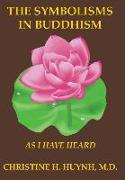- Start
- The Symbolisms in Buddhism
The Symbolisms in Buddhism
Angebote / Angebote:
This book is organized into chapters covering the key topics that comprise the core philosophy of Buddhism. The first two chapters go into great depth to define who the Buddha is and the significance of the events in his life. It is important to understand the life history of a teacher who revealed the philosophies of truth, which have become well-known as the practice of Buddhism. The Three Jewels are introduced as the Buddha, the Dharma, and the Sangha, they are the three foundations of faith that a practitioner takes refuge in. The Vesak Celebration describes the three important events of the Buddha's life consisting of his birth, Enlightenment, and Nirvana. The terminologies of "Enlightenment" and "Nirvana" are defined in detail as they will be applied in the practice outlined in subsequent chapters. The next few chapters discuss the main doctrines of study in Buddhism, which are the Four Noble Truths, the Noble Eightfold Path, the Thirty-Seven Paths to Enlightenment, the Middle Path, Cause and Condition, and Cause and Effect. These doctrines reveal the true nature of our life as well as the virtuous path to follow in order to transform our karma. The Buddha teaches that the presence of forms and phenomena are contingent upon sufficient favorable conditions, and their absence occurs when these conditions are no longer present. Karma explains the reasons why we have blessings and sufferings in life, therefore, it is important to regulate our thoughts, speech, and actions as they are the factors that culminate into our resulting karma. Chapters seven through eleven describe the environment at a Buddhist temple and the symbolisms of the objects and statues of the Bodhisattvas and Buddha at the altar. Symbols represent the teachings and the vows that practitioners should commit to practice. Chapters twelve through sixteen define the Five Aggregates that make up the state of our existence and how we should mindfully recognize them in our practice and daily interactions. Here, the important philosophies of impermanence, non-self, non-reality, and interbeing are explained in relation to their corresponding symbolic objects. Chapters seventeen through nineteen define the differences between wisdom and knowledge and the steps to practice the Five Vehicles to attain wisdom, foster compassion, and generate blessings. The chapter on the Five Vehicles explains in great detail the philosophies and practice in order to achieve the enlightened and virtuous mind. Chapter nineteen, "The Practice, " describes at great length on how to apply the Dharma teachings to our life. This is an important chapter to review and reread to thoroughly understand the foundations of practice. The last chapter summarizes and lists the teachings and philosophies in a numerology that is commonly used throughout Buddhist studies, as this was how the Buddha's teachings were orally transmitted to facilitate memorization. This is where we can reflect back and review the teachings so as to apply them to our daily practice. It is important to emphasize that both the contents and writing style throughout this book were written to capture what was heard from the sermons of the Venerable Thích Pháp Hòa. Hence the subtitle, As I Have Heard.
Folgt in ca. 15 Arbeitstagen
